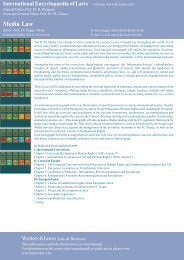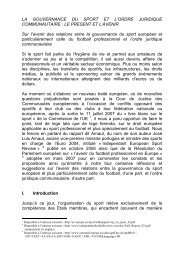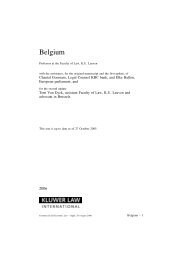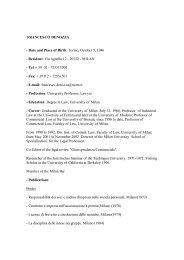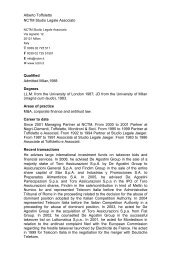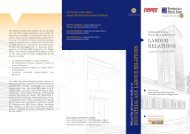24–28 General Introductioning text rarely are present in federal constitutional law because the federalconstitution has been so rarely amended.24. The function <strong>of</strong> state constitutions, not surprisingly, dictates their form.Generally speaking, because <strong>of</strong> the necessity to enunciate specific limitationson otherwise virtually unlimited governmental power, state constitutions containa high level <strong>of</strong> detail with respect to the structure and operations <strong>of</strong> government.For example, most state constitutions contain long articles on taxation andfinance, two <strong>of</strong> the most important functions <strong>of</strong> any government. Theseprovisions restrict state government taxing and spending in a range <strong>of</strong> ways thatis unfamiliar in the federal government.25. Further, because state constitutions are easier to amend than the federalConstitution, they have accumulated many layers <strong>of</strong> limiting details reflectingthe concerns <strong>of</strong> citizens during the various eras <strong>of</strong> American history. Forexample, evidence <strong>of</strong> the periods <strong>of</strong> distrust <strong>of</strong> the legislature, the IndustrialRevolution, the Progressive Movement, Jacksonian democracy, the settling <strong>of</strong>the West, bankruptcy in public finance, concern for efficient management, andmany other matters can be seen clearly in any modern state constitution.26. Finally, the state constitutions include numerous mechanisms for directpopular involvement in governmental decisions that have no analog in thefederal Constitution. Amendments or revisions <strong>of</strong> state constitutions themselvesmust be ratified by the voters before they can take effect. Beyond this fundamentalpoint, however, direct citizen involvement in such governmentaldecisions as borrowing public funds, levying certain taxes, and even, in somestates, approving gambling operations, is <strong>of</strong>ten required by state constitutions.States with initiative and referendum provisions in their constitutions obviouslypermit direct popular participation in the lawmaking process itself. Recallprovisions under which elected <strong>of</strong>ficials may be removed from <strong>of</strong>fice prior toexpiration <strong>of</strong> their terms <strong>of</strong> <strong>of</strong>fice supplement the more familiar electionmechanisms. Also, many states permit citizen litigation over governmentalmatters by authorizing a wide range <strong>of</strong> taxpayer lawsuits. None <strong>of</strong> theseexamples <strong>of</strong> popular participation in governmental decisions are present in theU.S. Constitution.§7. THE FORM OF SUB-NATIONAL CONSTITUTIONS27. An American state constitution is a single document. Despite thediversity among state constitutions, each state’s constitution shares certainstructural features with the constitutions in other states. Typically, an Americanstate constitution includes the following elements:28. Preamble: The preamble is a short statement <strong>of</strong> the purposes <strong>of</strong> thepolitical society. Since the early nineteenth century, state preambles have16 – <strong>USA</strong> (Sub-national) Constitutional Law – Suppl. 34 (October 1999)
General Introduction 29–35typically included an acknowledgment <strong>of</strong> God’s existence and beneficence.These preambles have no legal force.29. Declaration <strong>of</strong> Rights/Bill <strong>of</strong> Rights: These provisions protect certainfundamental rights against state, local, and (sometimes) private abridgement.Typical provisions include guarantees <strong>of</strong> freedom <strong>of</strong> speech and <strong>of</strong> the press,the free exercise <strong>of</strong> religion, the right to a jury trial, and various rights <strong>of</strong>defendants in criminal prosecutions, such as restrictions on unreasonablesearches and seizures, bans on compelled self-incrimination, and the right tocounsel. In addition, state declarations <strong>of</strong> rights <strong>of</strong>ten include rights notexpressly recognized by the federal Constitution, such as the right to a legalremedy and a recognition <strong>of</strong> gender equality.30. Separation <strong>of</strong> powers: This provision, found in about two-thirds <strong>of</strong> stateconstitutions, expressly requires a separation <strong>of</strong> governmental powers, forbiddingdual <strong>of</strong>fice-holding and confining each branch <strong>of</strong> government to the exercise<strong>of</strong> its own powers.31. Suffrage: This article elaborates the qualifications for voting in stateelections.32. Legislative Article: This article describes the structure <strong>of</strong> the statelegislature and defines the qualifications and mode <strong>of</strong> selection <strong>of</strong> its members.Because the state legislative power is considered to be plenary, the legislativearticle does not grant power to the legislature. Rather, it imposes variouslimitations on the legislative power. Some <strong>of</strong> these limitations relate to theprocess <strong>of</strong> legislation (e.g., requirements as to the form <strong>of</strong> bills, the range <strong>of</strong>subjects a single bill can encompass, and the procedures by which a bill is tobe considered and adopted). Other limitations relate to the substance <strong>of</strong>legislation.33. Executive Article: The executive article creates the various constitutional<strong>of</strong>fices and indicates how they are to be filled. It also prescribes thesphere <strong>of</strong> authority <strong>of</strong> each <strong>of</strong>ficer and the division <strong>of</strong> responsibility amongthem, indicating the extent to which the governor or other <strong>of</strong>ficials can exerciseauthority over their fellow executive <strong>of</strong>ficers. One effect <strong>of</strong> the ‘constitutionalization’<strong>of</strong> executive <strong>of</strong>fices and agencies is to limit the legislature’s opportunitiesto reorganize the state’s executive branch.34. Judicial Article: The judicial article creates the state’s courts, definestheir jurisdictions, and explains how judges are to be selected. It also typicallygrants to the chief justice <strong>of</strong> the supreme court supervisory power over thesystem <strong>of</strong> courts and to the supreme court various non-adjudicatory powers, suchas the power to regulate the legal pr<strong>of</strong>ession.35. Local government: The local government article provides for thecreation <strong>of</strong> units <strong>of</strong> local government and specifies their structure and powers.Constitutional Law – Suppl. 34 (October 1999) <strong>USA</strong> (Sub-national) – 17
- Page 1 and 2: United States of AmericaSub-nationa
- Page 3 and 4: The AuthorsG. Alan Tarr is Distingu
- Page 5 and 6: Table of ContentsThe Authors 3Gener
- Page 7 and 8: Table of Contents§ 2. Political Pa
- Page 9 and 10: General Introduction1§1. THE SUB-N
- Page 11 and 12: General Introduction 2-6§2. TYPES
- Page 14 and 15: 14-19 General Introductionofficials
- Page 18 and 19: 36-39 General IntroductionOlder loc
- Page 20 and 21: General Introduction20 - USA (Sub-n
- Page 22 and 23: 43-47 Selected BibliographyRobert F
- Page 24 and 25: Selected Bibliography24 - USA (Sub-
- Page 26 and 27: 52-53 Part I, Ch. 1, Constitutional
- Page 28 and 29: 56-57 Part I, Ch. 1, Constitutional
- Page 30 and 31: 60-63 Part I, Ch. 1, Constitutional
- Page 32 and 33: 69-70 Part I, Ch. 1, Constitutional
- Page 34 and 35: 74-76 Part I, Ch. 1, Constitutional
- Page 36 and 37: 80-83 Part I, Ch. 1, Constitutional
- Page 38 and 39: 86 Part I, Ch. 1, Constitutional Fo
- Page 40 and 41: 125-127 Part II, Ch. 1, Generallegi
- Page 42 and 43: 129Chapter 2. Head of the Sub-natio
- Page 44 and 45: 135-138 Part II, Ch. 3, The Legisla
- Page 46 and 47: 143-145 Part II, Ch. 3, The Legisla
- Page 48 and 49: 150-153 Part II, Ch. 3, The Legisla
- Page 50 and 51: 185 Part III, Ch. 1, Sub-national C
- Page 52 and 53: 191-197 Part III, Ch. 2, Fundamenta
- Page 54 and 55: 203-205 Part III, Ch. 2, Fundamenta
- Page 56 and 57: 209-212Chapter 4. Judicial Control
- Page 58 and 59: Part III, Ch. 5, Legal Position of
- Page 60 and 61: 216-218Chapter 2. Constitutional St
- Page 62 and 63: 223-224 Part IV, Ch. 3, Evolution o
- Page 64 and 65: Illinois ConstitutionSection 5. Rig
- Page 66 and 67:
Illinois ConstitutionSection 16. Ex
- Page 68 and 69:
Illinois ConstitutionArticle IV - T
- Page 70 and 71:
Illinois Constitutionmembers electe
- Page 72:
Illinois ConstitutionSection 12. Le
- Page 75 and 76:
Illinois ConstitutionSection 16. Se
- Page 77 and 78:
Illinois ConstitutionSection 8. Ass
- Page 79 and 80:
Illinois Constitution(e)(f)(g)are J
- Page 81 and 82:
Illinois Constitution(d)(e)treasure
- Page 83 and 84:
Illinois Constitutiongovernmental s
- Page 85 and 86:
Illinois ConstitutionSection 2. Non
- Page 87 and 88:
Illinois Constitution(c)(d)(e)(f)gu
- Page 89 and 90:
Illinois Constitutioncandidates for
- Page 91 and 92:
Illinois Constitutionfiled with the
- Page 93 and 94:
IndexThe numbers given are paragrap




